Three articles on spirituality in one issue? If you are wondering, “What was he thinking!”, let me explain by way of analogy as I describe my interest in art pottery.
Like many family physicians, I pursue a number of passions. My parents instilled in me a love of antiques and an excitement about collecting. What began as casual admiration of a decorative tile floor at the Josyln Art Museum in Omaha, Nebraska, soon became a feverish hunt. I discovered that reproductions of these tiles, made from the original molds, were produced at the Moravian Pottery in Pennsylvania. Having purchased a few reproductions, I was soon in passionate pursuit of art tile produced in the US at the turn of the century (yes, I know this ranks in the top 10 of eccentric hobbies). Of course, I had to visit other historical potteries, such as the Rookwood Pottery here in Cincinnati. I subscribed to the Journal of the American Art Pottery Association (take that, JAMA). Soon I wanted to make tiles, and so took classes in throwing pots, hand-building, and sculpting. To design better tiles, I had to learn to draw, and from there ... you get the idea.
Indeed, I have come to believe that much of our lives revolves around finding passion and meaning. For some of us, it is found in relationships with family and friends, in contemplation of nature, and, for many of you, in religious worship. Unfortunately, as physicians, we too often ignore our patients’ spiritual health. I hope, after reading this issue of JFP, you will agree that we all can practice more effectively by understanding our patients’ spiritual perspectives.
Throughout my journey described above, I have also been reminded about the value of experience. Only experience demystifies the way a glaze pools and puddles or the manner in which clays fire. Wise potters, collectors, and dealers have greatly contributed to my understanding and appreciation of tile. While in medicine it has become almost cultish to discount personal experience, I am regularly reminded—particularly when working with my senior colleagues—of the value of the “wisdom of the ageds” (as my colleague, Rick Ricer, has coined). Rick spent his sabbatical asking physicians across the country about their “Practice Pearls”—and we will be regularly sharing these unabashedly personal observations (see page 649).
As always, I invite you to share your comments and experiences from practice. While you may find this issue thought-provoking, even a bit challenging, I trust you will find some relevance to your work.



